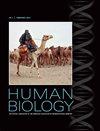玛雅人的遗传概况:线粒体DNA单倍群
4区 生物学
Q2 Medicine
引用次数: 4
摘要
研究人员在75名现代玛雅人、24名殖民时期玛雅人以及1名来自墨西哥金塔纳罗奥的前哥伦布时期玛雅人身上鉴定出线粒体DNA单倍群A、B、C和D。我们将这些数据与文献中报道的21个玛雅人的数据一起进行了检查,其中包括647个现代玛雅人和71个古代玛雅人。一项基于生育和内婚制分析的人口统计学研究在两个现代玛雅人群中进行,以确定影响线粒体单倍群遗传多样性的文化因素。大多数现代和古代玛雅人的线粒体单倍群频率a、C、B和D按降序排列,在一些人群中没有单倍群D。只考虑至少有50个个体的现代玛雅人,来自恰帕斯的今天的Tzotzil和Lacandon群体显示出最高和最低的遗传多样性,分别为0.706和0.025。我们的研究结果显示,除了今天来自恰帕斯的Tojolabal和Lacandon种群外,玛雅种群之间存在微小的遗传差异。恰帕斯地区的拉坎东人与其他玛雅人的不同之处在于,他们几乎只有单倍群a。这一结果表明,拉坎东人有着长期的隔离和内婚历史,也可能是拉坎东雨林内部的奠基人效应。当代Tojolabal人口是唯一一个不寻常的线粒体haplogroup模式,表现出haplogroup B的频率高于和缺乏haplogroup C .小样本大小,哥伦布发现美洲大陆前的科潘玛雅显示haplogroup C的含量高和低频率haplogroup d .玛雅人口的遗传同质性是一个共同起源的象征,几乎连续长期基因流动在整个集团的一般隔离,与起源不同的纳华人形成鲜明对比。我们的人口统计研究表明,在金塔纳罗奥的现代玛雅人口中,高生育率和高水平的内婚制与他们普遍的低遗传多样性是一致的。我们认为,古代和现代玛雅人之间的遗传相似性之所以持续存在,是因为强烈的社会凝聚力和身份意识影响了他们的婚姻习俗,使这个文化群体保持孤立。这些因素限制了玛雅地区内部的基因流动,阻碍了玛雅人之间的分化。在半岛内的遗传分化的辨别受到文献中缺乏采样文件的限制。本文章由计算机程序翻译,如有差异,请以英文原文为准。
Genetic Overview of the Maya Populations: Mitochondrial DNA Haplogroups
abstract We identified mitochondrial DNA haplogroups A, B, C, and D in 75 present-day Maya individuals, 24 Maya individuals of the colonial period, and 1 pre-Columbian Maya individual from Quintana Roo, Mexico. We examined these data together with those of 21 Maya populations reported in the literature, comprising 647 present-day Maya individuals and 71 ancient Maya individuals. A demographic study based on analysis of fertility and endogamy was carried out in two modern Maya populations to identify cultural factors that influence the mitochondrial haplogroup genetic diversity. Most present-day and ancient Maya populations show a distribution pattern of mitochondrial haplogroup frequencies A, C, B, and D in decreasing order, with haplogroup D absent in several populations. Considering only modern Maya populations with at least 50 individuals analyzed, the present-day Tzotzil and Lacandon populations from Chiapas show the highest and lowest genetic diversity, 0.706 and 0.025, respectively. Our results show small genetic differences between the Maya populations, with the exception of the present-day Tojolabal and Lacandon populations from Chiapas. The present-day Lacandon population from Chiapas differs from other Maya populations in showing almost only haplogroup A. This result suggests a long history of isolation and endogamy as well as a possible founder effect inside the Lacandonian rain forest. The contemporary Tojolabal population is the only one with an unusual mitochondrial haplogroup pattern, exhibiting a frequency of haplogroup B higher than A and the absence of haplogroup C. With a small sample size, the pre-Columbian Copán Maya show a high content of haplogroup C and a low frequency of haplogroup D. The genetic homogeneity of the Maya populations is indicative of a common origin and nearly continuous gene flow in the long term within a general isolation of the whole group, in contrast to the Nahua populations that had different origins. Our demographic study showed high fertility rates and high levels of endogamy in the present-day Maya populations from Quintana Roo that are consistent with their general low genetic diversity. We propose that the genetic similarity among ancient and present-day Maya populations persists due to a strong sense of social cohesion and identity that impacts their marriage practices, keeping this cultural group isolated. These factors have constrained gene flow inside the Maya region and have impeded the differentiation among the Maya. Discernment of genetic differentiation within the peninsula is constrained by the lack of sampling documentation in the literature.
求助全文
通过发布文献求助,成功后即可免费获取论文全文。
去求助
来源期刊

Human Biology
生物-生物学
CiteScore
1.90
自引率
0.00%
发文量
88
审稿时长
>12 weeks
期刊介绍:
Human Biology publishes original scientific articles, brief communications, letters to the editor, and review articles on the general topic of biological anthropology. Our main focus is understanding human biological variation and human evolution through a broad range of approaches.
We encourage investigators to submit any study on human biological diversity presented from an evolutionary or adaptive perspective. Priority will be given to interdisciplinary studies that seek to better explain the interaction between cultural processes and biological processes in our evolution. Methodological papers are also encouraged. Any computational approach intended to summarize cultural variation is encouraged. Studies that are essentially descriptive or concern only a limited geographic area are acceptable only when they have a wider relevance to understanding human biological variation.
Manuscripts may cover any of the following disciplines, once the anthropological focus is apparent: human population genetics, evolutionary and genetic demography, quantitative genetics, evolutionary biology, ancient DNA studies, biological diversity interpreted in terms of adaptation (biometry, physical anthropology), and interdisciplinary research linking biological and cultural diversity (inferred from linguistic variability, ethnological diversity, archaeological evidence, etc.).
 求助内容:
求助内容: 应助结果提醒方式:
应助结果提醒方式:


